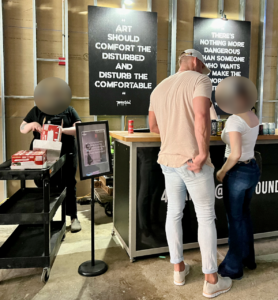
Visitors to the exhibit grab drinks at the bar. Photo by John Griswold
The traveling Banksy exhibit looked good in the online ad, and there was a warning of “high sell-out risk.” I bought quickly, for two of us, mine a VIP ticket for extra access, so I could write about everything there might be to see, and it came with an exhibit poster. A few hours later I told a friend what I had done, and he scoffed and said it was an unauthorized exhibit and thought to be kind of a scam.
Of course it was unauthorized! I felt dumb. Banksy, whoever he is (wink), is not “represented by any…gallery or institution.”
What’s more, his website says, “Members of the public should be aware there has been a recent spate of Banksy exhibitions none of which are consensual. They’ve been organised entirely without the artist’s knowledge or involvement. Please treat them accordingly.”
“I wrote ‘copyright is for losers’ in my (copyrighted) book and still encourage anybody to take and amend my art for their own personal amusement, but not for profit or making it look like I’ve endorsed something when I haven’t. Thanks.”
And there, it seems, is the interesting rub. Without copyrighting his art and having to reveal his identity legally (not to mention reducing some of the anarchical intent of his work in the process), he cannot apparently do much to prevent shows such as “Banksyland,” now touring 32 cities internationally.
“BANKSYLAND is an international touring exhibition that immerses audiences in the works of the world’s most infamous and elusive artist: BANKSY,” the promoter’s site says. “The one of a kind exhibit includes original and studio works, salvaged street artworks, and never-before-seen immersive installations. Experience the mystique and cultural impact of the most sought after artist of our time, live and in person.”
The “secret” location of the installation was to be announced only a week or so before it opened; as it turned out, they emailed me the location exactly one minute after I was due to be there, but the press had already announced where it would be—a converted industrial space filled with restaurants, a bar, and goofy golf. I had spent the money; we went.
The exhibit was cheap-looking and had a mix of some 80 pieces. There were art prints of some of Banksy’s iconic images, such as the cop in body armor with a smiley face; multimedia showing his art in situ; a couple of pieces converted to 3D, such as a large statue of the guy with a bandanna over his mouth and nose throwing a bouquet of flowers as if it is a Molotov; neon words on a wall (“Sorry! The lifestyle you ordered is currently out of stock.”); and a video of his refugee rescue boat, the MV Louise Michel, seized three weeks ago by the Italian coast guard.
When I leaned in to see the explanatory tags next to the pieces, many were from “private collectors,” and several in the “Banksyland private collection.” (I take this to mean the company had made them and used them in their exhibits.) There was no way to know, as more than one outlet reported, what was “genuine,” or what that would even mean in the case of Banksy, even more than, say, whether a Monet has a veritable provenance. Banksy’s stuff often has to come down with the wall it is attached to, if it is to be removed from its context.
My friend was unimpressed and said the exhibit made the art seem too easy and repetitive. I had to agree; while I have been and remain a fan of the artist, seeing this much of it in one place, without context, turned it into a one-trick pony. Little girl holding something? Make it a nuke, not a teddy bear. Christ being crucified? Have him hold bags from expensive department stores in both hands.
So many of Banksy’s more recognizable works were originally stenciled somewhere they were not meant to be in order to call attention to imbalances of power and repression. This exhibit itself was a sort of abuse, but mostly in cynical terms. I took my free poster (“Banksy: the world’s most sought after artist,” it reads, under a collage of his images, reproduced as near-blobs. “Unauthorized / Uncensored”) from the employee at the pop-up gift shop and fled, vowing to buy a local artist’s work the next time I needed a birthday gift for someone.
